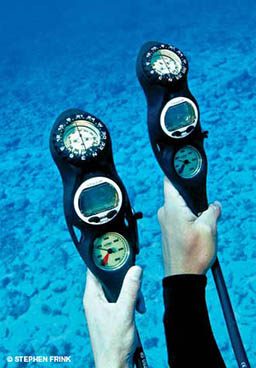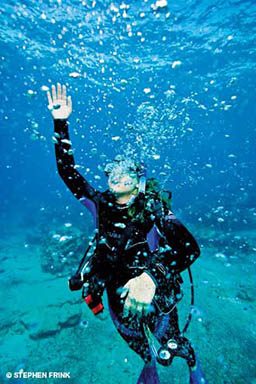Diver No. 1
A 37-year-old male diver with approximately 30 lifetime dives was doing his first night dive. It was also his first cold-water and first drysuit dive. He was healthy and not taking any medications. The diver descended to 95 feet, breathing air and using a dive computer. He had some difficulty beginning his descent due to his failure to adjust his weight to compensate for the increased buoyancy of the drysuit. After some time at the bottom he checked his air gauges and found he had less than 300 psi remaining. He signaled to his buddy he was terminating the dive and began to ascend. Because of inexperience, the ascent was not fully controlled, and the diver reported feeling “close to panic.” After surfacing, he waited for his buddy, and they swam back to shore. The diver never experienced symptoms, but he contacted DAN® the next day to discuss the events and inquire if he was still in any danger.

Diver No. 2
A 72-year-old male with hundreds of lifetime dives, including several technical dives, was participating in a series of wreck dives with three buddies. He was not known to have any medical conditions or to be taking any medications; he was reportedly in good general health. The first dive was an uneventful wreck dive to 112 feet for 28 minutes. The second dive was planned as a shallower dive, and the diver’s three buddies descended ahead of him. His body was later found floating on the surface a half mile away from the initial descent area. One witness reported the decedent’s snorkel was in his mouth when his body was recovered. His weight belt was not in place, and his tank was empty. Circumstances indicated he made a buoyant emergency ascent. His computer recorded a nine-minute dive to 29 feet. Apparently, each of the four divers used a single tank (per diver) to make both dives. The autopsy findings were consistent with drowning.
Diver No. 3
The diver was a 24-year-old female with approximately 100 lifetime dives. She reported a history of regular exercise and good general health, and she denied taking any medications. Her dives were warm-water ocean dives hunting lobster. The first dive was along a reef structure at a maximum depth of 73 feet, and some time passed before she located her prey. Trying to capture one lobster required a short chase and raised her respiratory rate. The diver checked her gauge only when she became aware of increased breathing resistance. It displayed “0.” She admitted to panicking and swimming rapidly toward the surface. She failed to jettison her weights or inflate her BCD, which she would have to have done orally because of her empty cylinder. Other divers saw her struggling to keep her head above water and remove the regulator from her mouth. They helped her return to the dive boat, where she had difficulty breathing and coughed up pink, frothy sputum. Crew members provided oxygen and returned to shore, where emergency medical service personnel were waiting. She was transported to the hospital and diagnosed with seawater aspiration. She developed pneumonia and was hospitalized for two weeks, after which she was discharged with no residual problems.
Discussion
To many people who drive a car every day, running out of fuel may seem improbable, but according to AAA it is a daily occurrence. Likewise, ineffective breathing-gas management while diving is a recurrent problem. During peak season, DAN Medicine speaks with at least two divers every week who have concerns about having made a “rapid ascent” after finding themselves low on or out of breathing gas. Although the incidence of fatal injuries is very low, about 41 percent of dive fatalities involve insufficient breathing gas as the trigger that led to other harmful events and, ultimately, the death of the diver. Drowning is the leading cause of death in these situations.

The reasons behind bad gas management are numerous and varied. The first diver in this case study introduced new environmental factors (a night dive in cold water) and new equipment (a drysuit), and he failed to make adjustments for any of it. As a result, poor buoyancy control, unfamiliar equipment and stressful dive conditions increased his air consumption and reduced the volume in his tank faster than usual. He had an adequate gas supply to make a safe ascent, but his inexperience left him unable to control his ascent rate.
The second diver started his second dive with a practically empty tank, which was either an oversight or a bad decision. He followed his training in making a buoyant emergency ascent, though he clearly ignored it in failing to ensure he had an adequate gas supply at the start of the dive. The third diver was involved in vigorous and distracting activities. These increased her respirations and sped up the depletion of her gas supply, which she did not monitor carefully. She failed to follow her training by not releasing her weights to increase her buoyancy at the surface.
Exertion, stress, anxiety and environmental factors can all increase respiratory rate. Activities like lobster hunting or spearfishing may consume gas supplies five to 10 times faster than usual. Wearing too much or too little weight can cause divers to work harder, increasing gas consumption. Regardless of factors, however, divers should monitor gas supply frequently and consistently.
Conclusion
When planning a dive, incorporate a breathing-gas limit in the plan. For example, a buddy pair might agree to head back to the exit point when the first diver has used a third or half of his breathing gas (not counting the reserve to be left in the cylinder at the end of the dive). Maintaining buddy contact can make a life or death difference. Safe diving practices and sharpening skills such as buoyancy control reduce the risk of a breathing-gas emergency but do not eliminate it completely. Proper responses to breathing-gas emergencies rely on experience and skill recall. Establishing and practicing responses are essential; confidence in being able to use an alternate air source provided by a buddy can lead to a much better outcome. Through planning and practice, effective breathing-gas management can become second nature and reduce the likelihood of a diving emergency.
© Alert Diver — Q2 Spring 2011